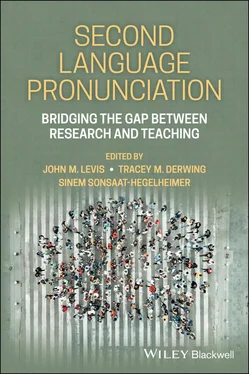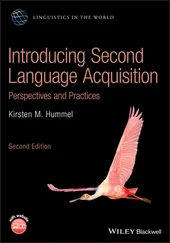Second Language Pronunciation
Здесь есть возможность читать онлайн «Second Language Pronunciation» — ознакомительный отрывок электронной книги совершенно бесплатно, а после прочтения отрывка купить полную версию. В некоторых случаях можно слушать аудио, скачать через торрент в формате fb2 и присутствует краткое содержание. Жанр: unrecognised, на английском языке. Описание произведения, (предисловие) а так же отзывы посетителей доступны на портале библиотеки ЛибКат.
- Название:Second Language Pronunciation
- Автор:
- Жанр:
- Год:неизвестен
- ISBN:нет данных
- Рейтинг книги:5 / 5. Голосов: 1
-
Избранное:Добавить в избранное
- Отзывы:
-
Ваша оценка:
- 100
- 1
- 2
- 3
- 4
- 5
Second Language Pronunciation: краткое содержание, описание и аннотация
Предлагаем к чтению аннотацию, описание, краткое содержание или предисловие (зависит от того, что написал сам автор книги «Second Language Pronunciation»). Если вы не нашли необходимую информацию о книге — напишите в комментариях, мы постараемся отыскать её.
Second Language Pronunciation: Bridging the Gap Between Research and Teaching
Second Language Pronunciation: Bridging the Gap Between Research and Teaching
Second Language Pronunciation — читать онлайн ознакомительный отрывок
Ниже представлен текст книги, разбитый по страницам. Система сохранения места последней прочитанной страницы, позволяет с удобством читать онлайн бесплатно книгу «Second Language Pronunciation», без необходимости каждый раз заново искать на чём Вы остановились. Поставьте закладку, и сможете в любой момент перейти на страницу, на которой закончили чтение.
Интервал:
Закладка:
In naturalistic contexts, when L2 pronunciation reaches a point where it is adequate for a learner’s communicative purposes, the motivation necessary to continue improving is likely to diminish. This may account for what Derwing and Munro (2015) have called the “Window of Maximal Opportunity” (WMO). While insufficient longitudinal data exists from which to accurately identify a precise point after which improvement in L2 pronunciation plateaus, evidence suggests that the WMO for obvious improvement in adult L2 learners’ pronunciation closes between six months and two years after their arrival in the L2 environment. The speed with which the WMO closes depends on individual learner characteristics (Piske et al., 2001). For example, not all learners struggle with the same L2 segments or suprasegmentals, even if they speak the same L1 (Derwing et al., 2012; Munro et al., 2015). Further, differences in phonetic aptitude predict ultimate attainment (Derwing & Munro, 2015; O’Brien et al., 2007). Some learners may be more fortunate than others in their access to input from the target speech community (Derwing et al., 2008), or they may have a stronger motivation to succeed (Baker Smemoe & Haslam, 2013; Moyer, 2014). Despite these limitations, there can be measurable improvement in individual sound categories beyond the WMO (Derwing & Munro, 2015). The effect of such incremental changes on L2 learners’ global foreign accent is limited, however. Derwing and Munro (2013) found no further improvement in English accent ratings for Slavic and Mandarin immigrants between two and seven years after their arrival in Canada. The Slavic group did evidence improvement in comprehensibility, however, which could be related to changes in pronunciation of individual sounds or suprasegmentals.
Instructed L2 Pronunciation Development
While limits on ultimate attainment in naturalistic learning contexts are well-established, instructed L2 pronunciation can provide an opportunity to re-orient learners’ selective perception towards phonetic cues that they have learned to ignore. Despite this fact, production-oriented approaches to teaching pronunciation have long-dominated the field (e.g., Celce-Murcia et al., 2010; Lyster et al., 2013; Thomson & Derwing, 2015). In the 1970s, Audiolingualism used spoken models, but only to introduce production rehearsal activities (Brown & Lee, 2015). In the 1980s, Communicative Language Teaching (CLT) largely neglected pronunciation instruction, focusing almost exclusively on communicative processes to the exclusion of form. While CLT appealed to adult L2 learners’ desire to communicate as quickly as possible, it largely recreated the naturalistic conditions under which L2 pronunciation is most resistant to change. In more recent years, while pronunciation instruction has regained a position of importance, instruction continues to be predominantly production-focused (e.g., Saito & Lyster, 2012).
Since we know that speech perception plays such a foundational role in accurate speech production, why is this not reflected in popular L2 pronunciation teaching methods? One reason for this disconnect is that L2 speech perception research is largely inaccessible to language teachers (Thomson, 2018a). It is typically published in technical journals and largely reports on laboratory-based studies, which may appear to lack relevance to the real world. Unfortunately, by ignoring this important research, pronunciation specialists are unprepared to teach in a way that addresses the cognitive-developmental features of pronunciation associated with speech perception (Derwing & Munro, 2015).
In laboratory studies, changes in L2 speech perception happen consistently and rapidly (Sakai & Moorman, 2018). Furthermore, perceptual training typically leads to improvement in production, albeit more slowly than in perception. The perceptual training technique with the most empirical support is High Variability Pronunciation Training (HVPT) (see Thomson, 2018a). This technique is based on evidence that to be effective, perceptual training needs to include variation in terms of the number of talkers whose voices comprise training stimuli and in the number of phonetic contexts (or words) in which target sounds are presented. Training on a single talker does not generalize to perception of the target sounds spoken by new talkers. Presentation of target sounds in multiple phonetic contexts is important because learning to perceive a sound in one context (e.g., the vowels in “hit” and “heat”) rarely transfers to perception of the same sound in different contexts (e.g., to the vowels in “sit” and “seat”) (Thomson, 2016, 2018a). There is also evidence that training target sounds using nonsense syllables/words is initially more effective than training using real words (Thomson & Derwing, 2016). This may be due to the ability to orient learners’ attention to sounds in nonsense words, without competition from meaning (Guion & Pederson, 2007). HVPT typically presents training stimuli by computer or mobile application. Learners hear training tokens and must respond by clicking/tapping on a symbol, letter, or word representing the sound that they just perceived. They then receive feedback on the accuracy of their responses. There is limited direct evidence for how to use HVPT to train suprasegmental features, but there is some indication that it would have a similarly beneficial effect (Thomson, 2018a).
The cognitive mechanisms underlying the benefits of HVPT over low variability training are not fully understood. One possibility is that all cognitive categories, by their very nature, contain variation. This means that learning a new category necessitates learning about the distribution of sounds that can occur within that category. Another possibility is that the use of multiple talkers maximizes the potential for a given L2 learner to encounter at least some tokens of target sounds that do not automatically assimilate to pre-existing L1 categories. There is evidence that L2 learners are more apt to recognize English vowels as belonging to a new category if those vowels were produced by a talker whose productions are acoustically distant from any confusable L1 vowel categories (Thomson, 2007). It remains unclear whether there is an optimal amount of variability. Programs claiming to be HVPT have used between 2 and 30 talkers, for example, and vary widely in the number of phonetic contexts utilized (Thomson, 2018a). It seems unlikely that using two talkers provides optimal variability, but using increasingly larger numbers may result in diminishing returns or make learning more difficult (Thomson, 2018a).
In addition to variation in stimulus talkers and phonetic contexts, the nature of corrective feedback (CF) has also been shown to impact perceptual learning. While corrective feedback of some sort is a feature of all HVPT training, Lee and Lyster (2017) explored what role specific types of correct CF play in the transfer of perceptual training to production. Their HVPT experiment tested CF in four conditions. One group received feedback only that their response was incorrect, but was not told what the correct response should have been. Three other groups received feedback when they were wrong, but also received additional input, either by hearing an example of the target item again, hearing an example of the non-target item they had selected, or hearing both the target and non-target sounds. Only the groups that heard either the target form or the non-target form as part of CF displayed transfer to production. Those that did not hear either target or non-target items, or those that heard both, did not improve in production. In sum, Lee and Lyster’s study confirms that drawing learners’ attention to errors, either through negative or positive evidence, contributes to learning, just as it does in L1 pronunciation development.
Читать дальшеИнтервал:
Закладка:
Похожие книги на «Second Language Pronunciation»
Представляем Вашему вниманию похожие книги на «Second Language Pronunciation» списком для выбора. Мы отобрали схожую по названию и смыслу литературу в надежде предоставить читателям больше вариантов отыскать новые, интересные, ещё непрочитанные произведения.
Обсуждение, отзывы о книге «Second Language Pronunciation» и просто собственные мнения читателей. Оставьте ваши комментарии, напишите, что Вы думаете о произведении, его смысле или главных героях. Укажите что конкретно понравилось, а что нет, и почему Вы так считаете.












